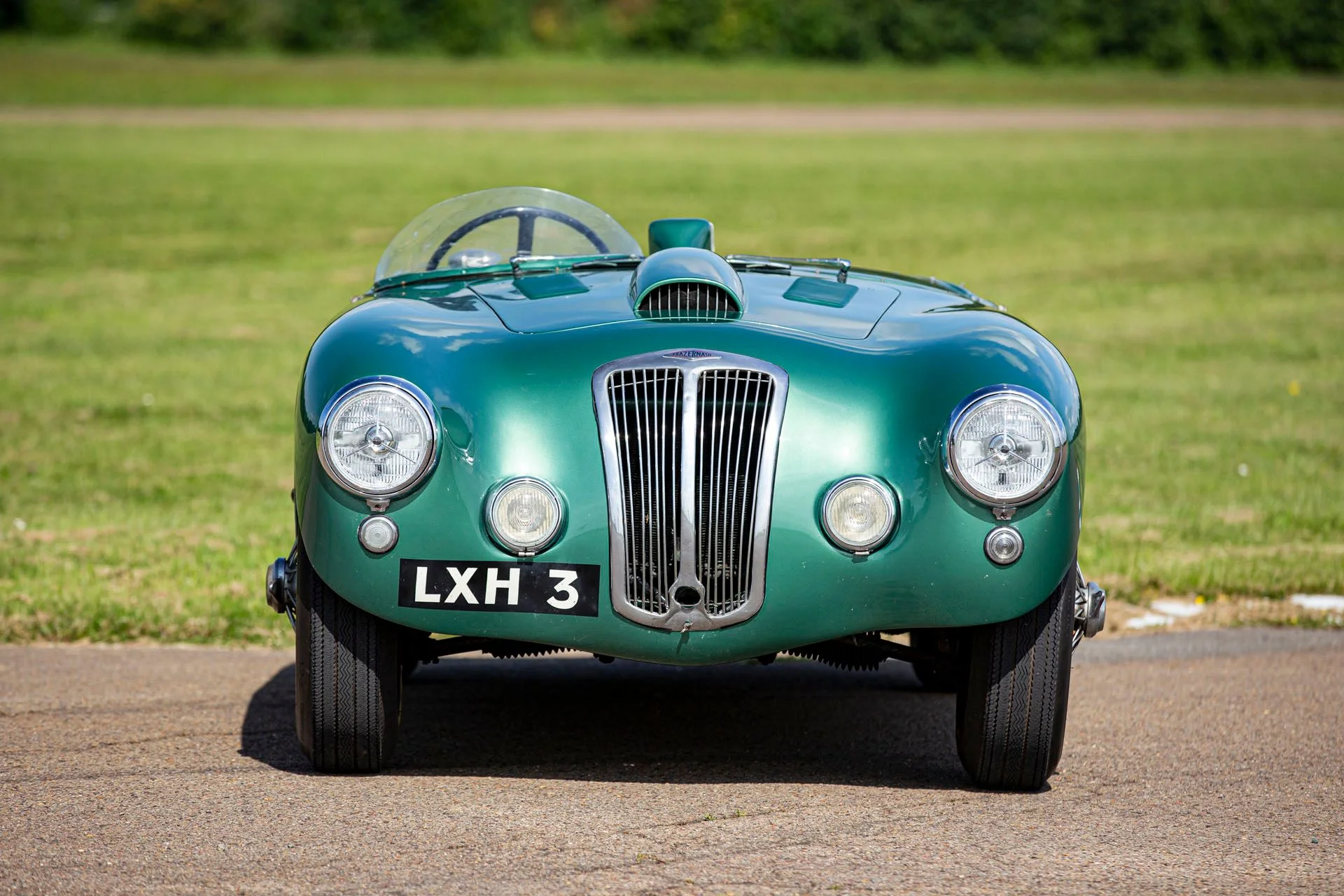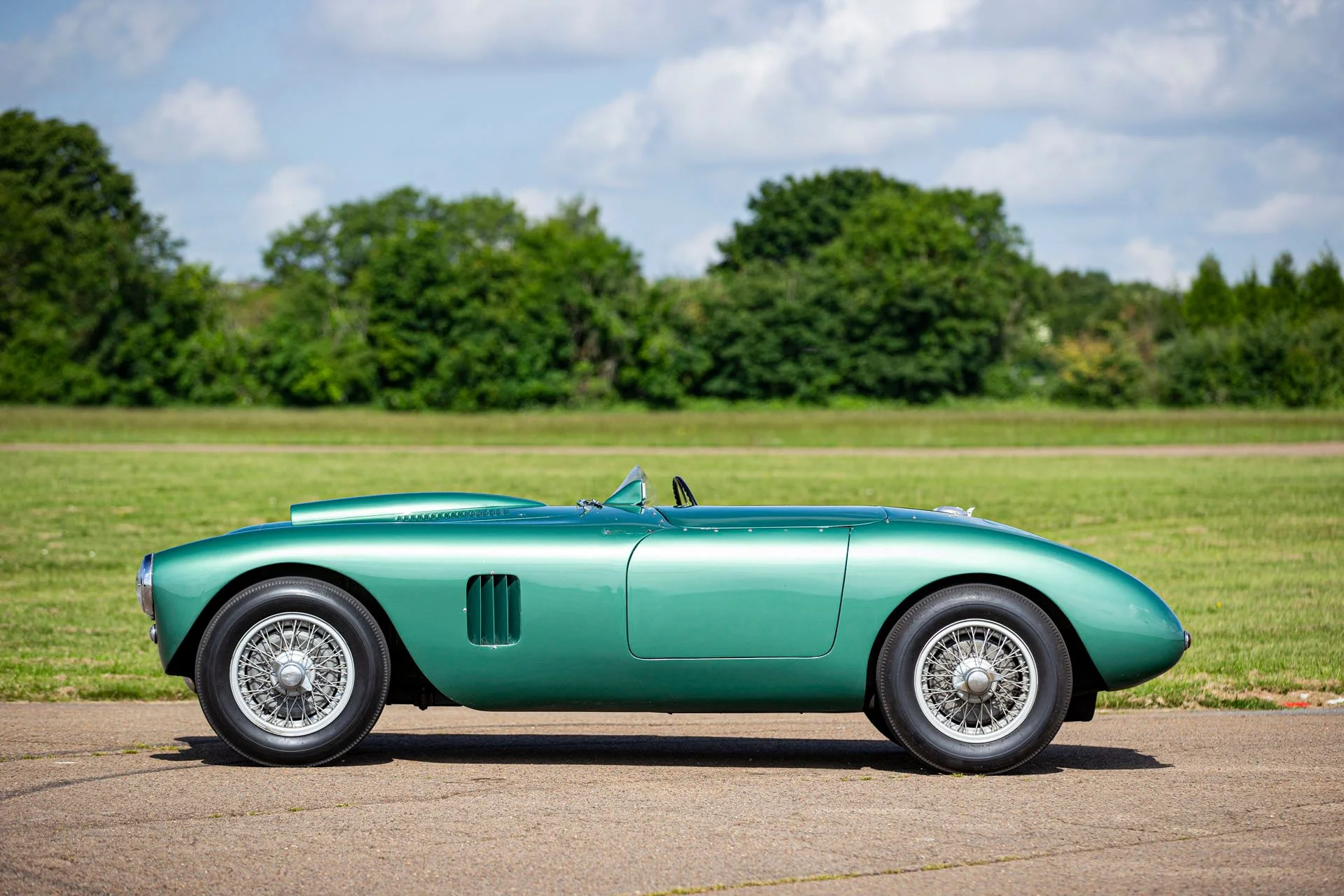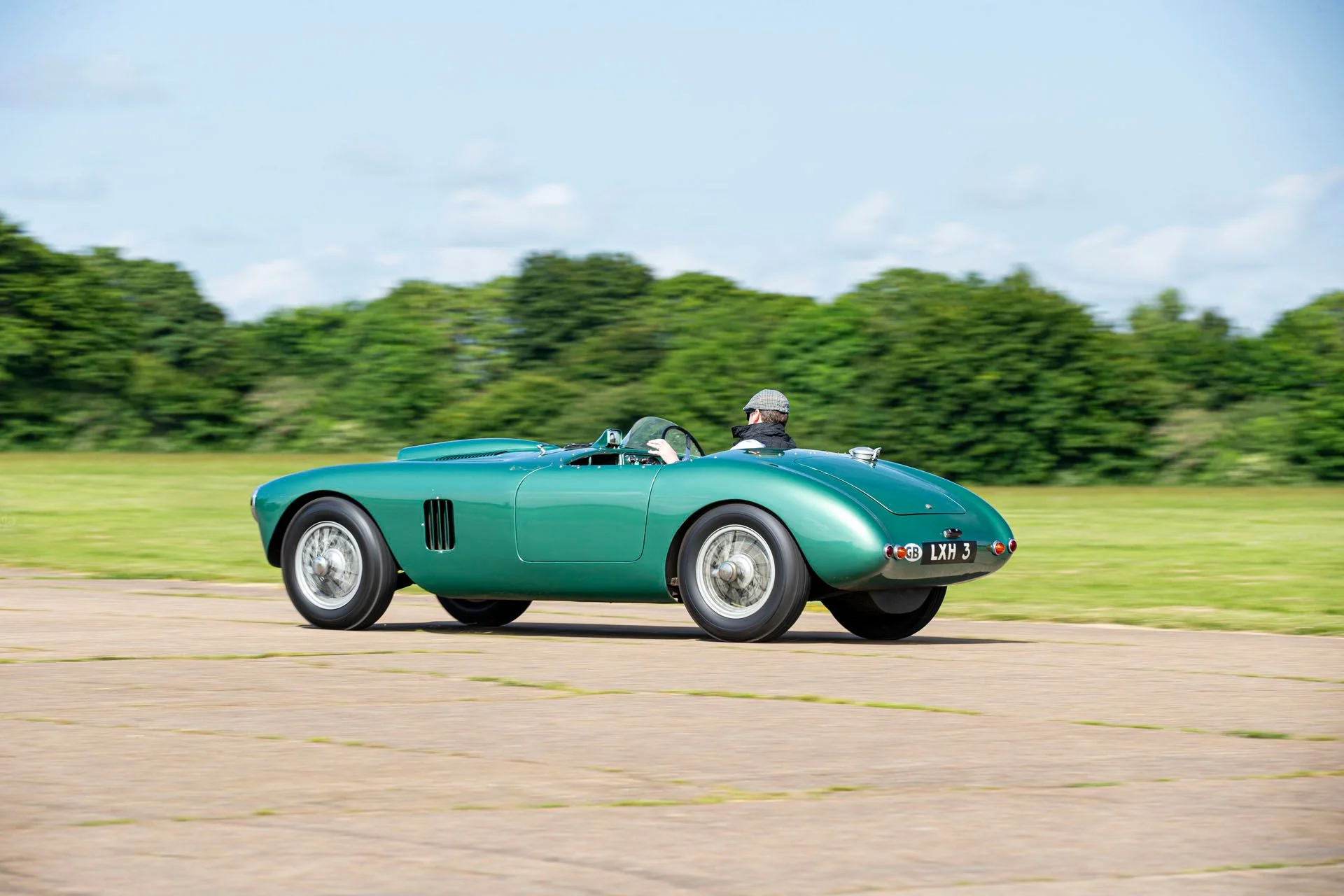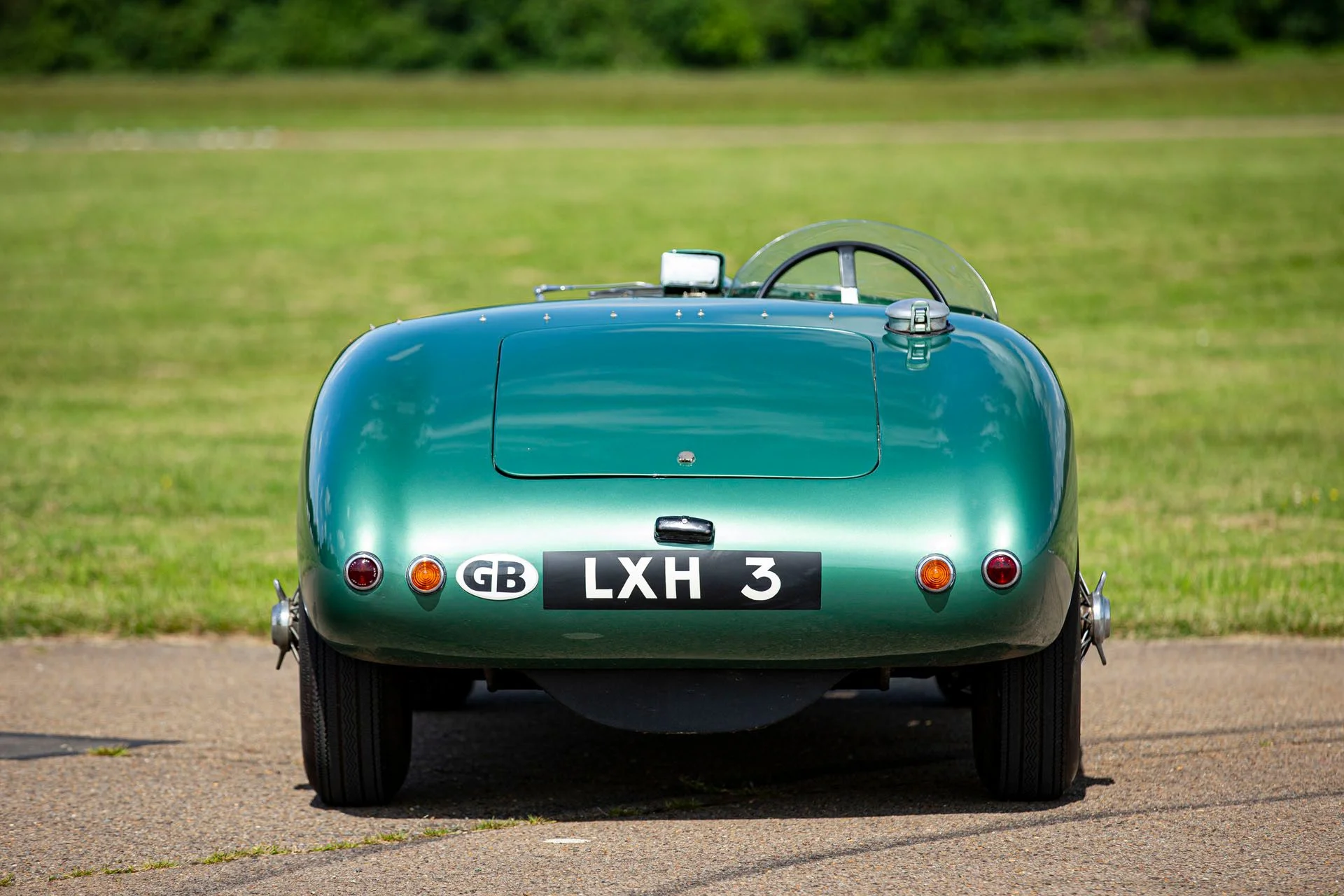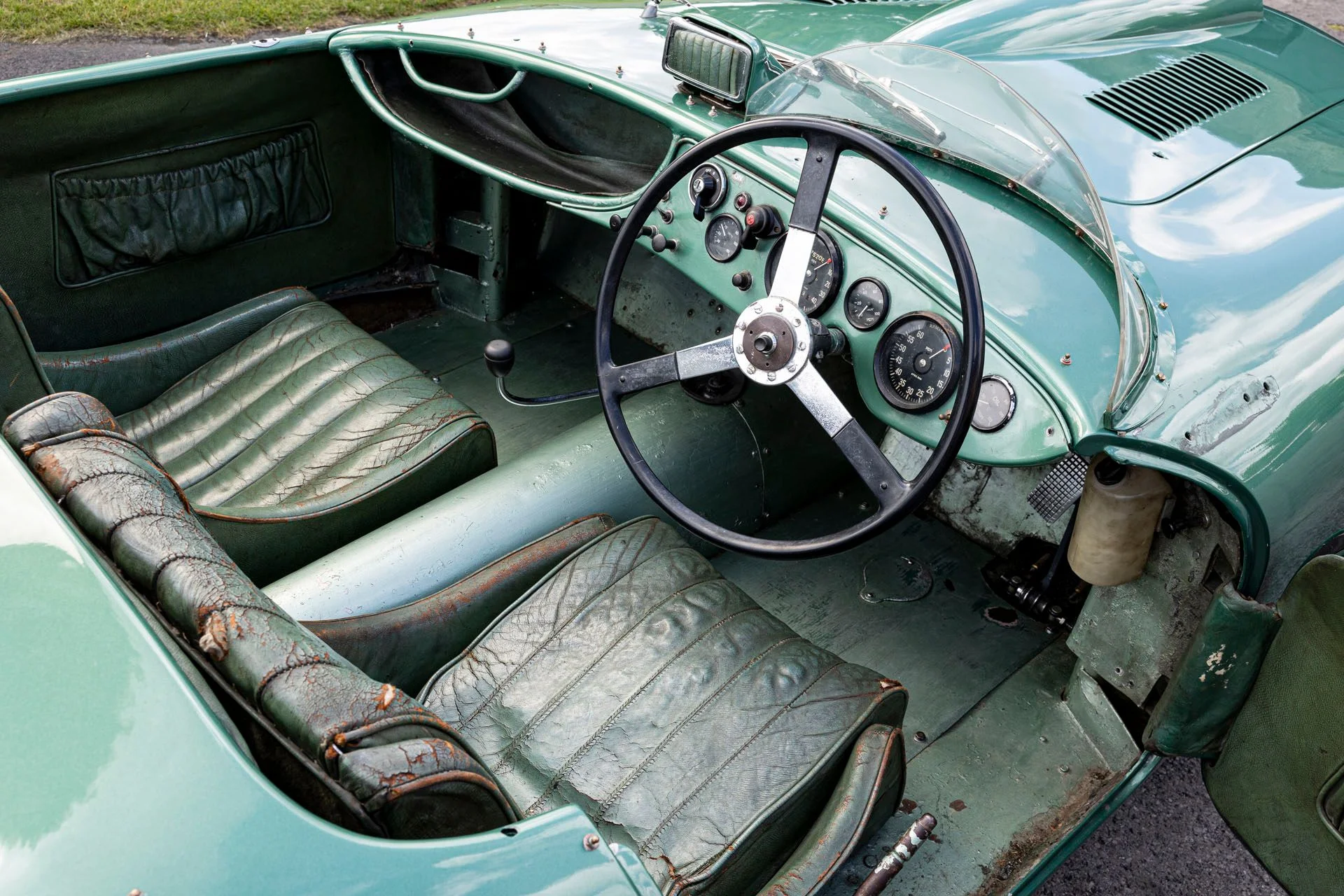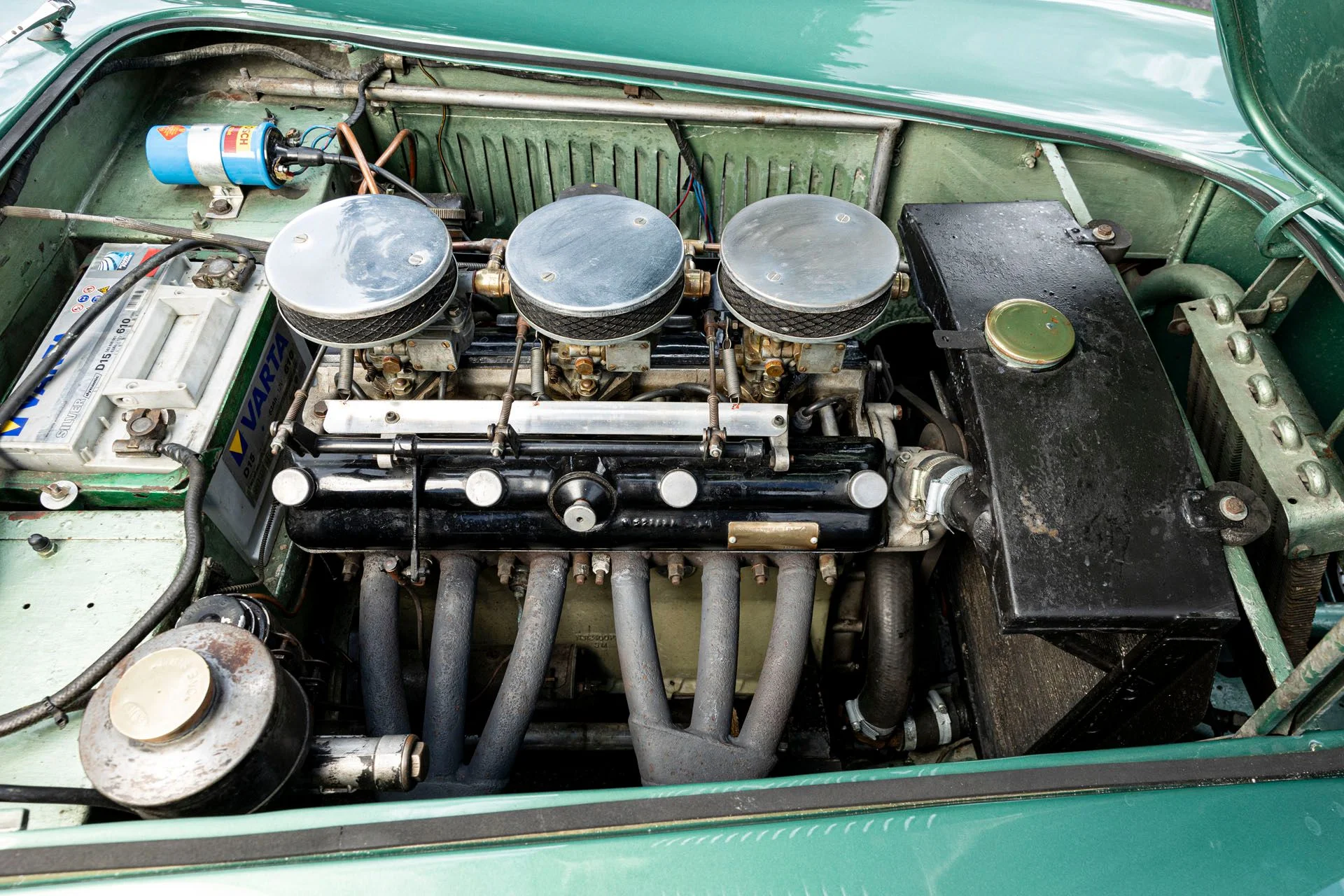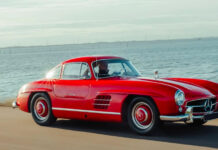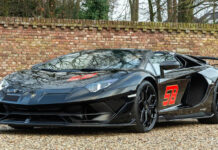Broad Arrow Private Sales is offering this Frazer Nash Targa Florio Sports Racing Roadster for sale.
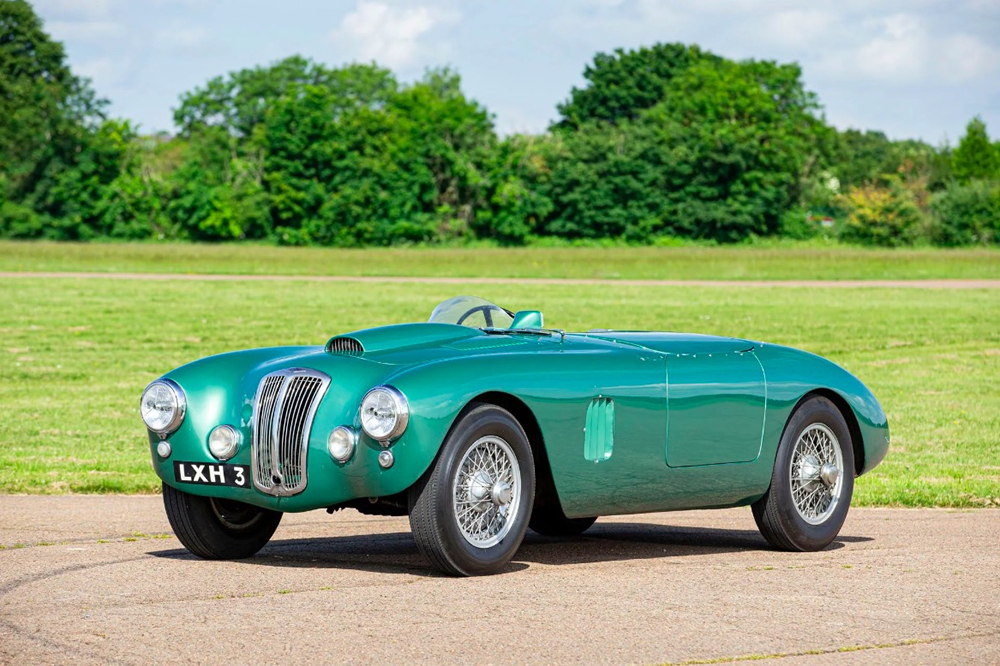
HIGHLIGHTS
- A veteran of two Le Mans 24 Hour races
- Long-term, single ownership of 53 years
- Originally constructed as a “Le Mans Replica”
- Converted by the Frazer Nash works in the winter of 1952 to a “Targa Florio” body to conform with international sporting regulations
- Offered for sale with a history file complete with 1952 and 1954 Le Mans photography among other races including Goodwood, Silverstone, and Brands Hatch
- Sure to be a welcome entrant at any of the top-flight historic events for which it is eligible
- Located in England
1951 FRAZER NASH TARGA FLORIO SPORTS-RACING ROADSTER
Chassis No. 421/100/150
Engine No. BS1 104
When it comes to international sports car racing there is one event that undeniably stands above the rest – namely, Les 24 Heures du Mans. The French endurance classic, that first ran nearly one hundred years ago, is undoubtedly the jewel in the crown of sports car racing and victory at the famed Circuit de la Sarthe is the prize that all sports car racers dream of winning. This 1951 Frazer Nash, “FN 150,” competed at the Le Mans 24 Hour race not once, but twice – initially for the 1952 edition in “Le Mans Replica” form and then again in 1954 in “Targa Florio” form. Often known by its UK registration number “LXH 3,” the Frazer Nash also competed at Tourist Trophy races as well as a number of well-known British circuits in period. The car is offered for sale from long-term ownership, having resided with the current custodian for over 53 years. In highly original form, much as it raced at Le Mans in 1954, “LXH 3” represents an excellent opportunity to acquire a highly original, much loved and much raced 1950s sports-racer, with impeccable provenance. It is, as such, eligible for numerous historic motor racing events worldwide including, of course, the Le Mans Classic, the Goodwood Members and Revival meetings.
To comprehend the evolution and development of the Frazer Nash after the Second World War, one need look no further than The Post-War Frazer Nash penned by James Trigwell and Anthony Pritchard – Palawan Press. This superb tome not only covers the story of the company post-war but also gives a succinct account of the history of each of the motorcars that were produced. As a company, Frazer Nash had been known to punch well above their weight from their earliest days. Be it on the Brooklands banking, at International Tourist Trophy Races or Alpine Trials the chain-driven Frazer Nash was hugely successful and certainly the British Sports car that many young men and women aspired to own. Competition use was as actively encouraged by the company then as it is by the superb Frazer Nash Car Club today. Building on the allure of the chain-driven cars, Frazer Nash enjoyed continued success throughout the late 1930s with the import, assembly, and sale of the Frazer Nash-BMW products, most notably in competition the 315, 319, and the indomitable 328. Production of sports cars was slow to commence after the Second World War in Britain as the ravages of conflict caused a shortage of supply in both materials and demand. In order to create the first post-war model, Frazer Nash employed many of the technological advances learnt from BMW pre-war. This link with BMW led to a rather natural course of action whereby Frazer Nash largely employed the 1,971 cc BMW-derived six-cylinder units now produced by the car division of the Bristol Aeroplane Company to power their new cars. The running gear of the new “Speed” or “Competition” models sat in a tubular-type chassis much like those that featured on the pre-war BMWs.
Suffice to say that, in line with their success pre-war, Frazer Nash continued to enjoy competition success and it is perhaps fair to say that it is the post-war cars that really catapulted their name into the limelight and gave the company greater recognition overseas—particularly in North America. In 1949 a privately entered works supported Frazer Nash was entered for the 24 Hours of Le Mans and finished in 3rd place overall and thus the name was thereafter changed from the “Speed” or “Competition” model to the “Le Mans Replica” model in celebration of this superb result. Other successes gave birth to other model names, with 6th Place overall at the 1950 Mille Miglia, overall victory at the 1951 Targa Florio (the only British car to win the event it its entire history) and victory in the 12 Hours of Sebring. The list of drivers who pedaled Frazer Nash motorcars post-war reads like a who’s who of top-flight 1950s international drivers and includes: Moss, Brooks, Salvadori, Hawthorn, and Cunningham to name but a few.
Chassis number 421/100/150 or “FN 150,” as offered for sale here, was built as a Le Mans Replica Model and delivered to its first owner, Rodney F. Peacock on the March 7 1951. Finished in a light grey color known as metallic beige it had red upholstery and matching red wheels. As a MK1 Le Mans Replica, it featured the “A-Frame” chassis and was powered by a Bristol 1,971 cc six-cylinder unit, numbered FNS1-25. It was first registered “LXH 3” to J.H. Peacock Ltd in March 1951. Like so many Frazer Nash, “FN 150” was almost immediately pressed into competition service and by the 31st March was on track with Peacock at Castle Combe for a club meeting. At this event, the original engine was damaged and subsequently replaced by the works with engine number FNS1-8 that Frazer Nash renumbered FNS1-25. Peacock then took part in the one-hour production car race at Silverstone, finishing in 8th place overall.
Rodney “Frank” Peacock competed extensively at club level but for the more significant international two-driver races he would share the driving with fellow garage owner and competent racer Gerald Arthur Ruddock – known as Gerry. “Frank & Gerry’s” first major international outing in ”LXH 3” was on the Isle of Man for the 1951 British Empire Trophy Race where a creditable 5th overall and 3rd in class was achieved behind Stirling Moss and Bob Gerard on similar cars. “LXH 3” was then driven by Peacock at Goodwood on 18 August 1951 and a picture of him at the famous circuit along side John Craig in FN 158 is featured on Page 57 of The Post-War Frazer Nash. From Goodwood, “Gerry & Frank” were again at the wheel of the Frazer Nash for the Tourist Trophy Race at Dundrod, held on 15 September 1951. An average speed of 75.55 mph gained them 9th overall and 3rd in class with again Stirling Moss the overall victor of the race, this time on a C-Type Jaguar.
In 1952 the anti was upped when “LXH 3” was entered for the Le Mans 24 Hour Race, to this day, the most significant race on the international sports-car racing calendar. Both the works Jaguar and Aston Martin teams failed to complete the race in their entirety. The failure of the top British works teams gifted overall victory and second place to the works Mercedes 300 SL of Lang/Riess & Helfrich/Niedemayer although only after the Talbot of Pierre “Levegh,” that he had piloted single-handedly for 23 hours, broke its crankshaft – a heroic and famous (if slightly foolhardy) effort. Peacock and Ruddock faired quite well in the Frazer Nash and kept out of trouble but the valances that they were required to fit between the wings and bodywork for the race affected the aerodynamics and thus the all-important top speed on the Mulsanne straight. With a few hours to go the wheels were coming loose on the Frazer Nash and thus Peacock and Ruddock slowed significantly for the last hours of the race in order to complete the race. “LXH 3” did complete the race, finishing 10th overall and 3rd in the 2.0-Litre Class behind the Scuderia Lancia Aurelia B20GTs at an average speed of 87 mph with 1,870 miles covered in the 24 Hours – a sterling effort for a private team at their first attempt.
Over the winter of 1952/53 the Frazer Nash was returned to the works at Isleworth and a new fully enclosed wheel “Targa Florio” body was fitted onto the original chassis in order that “FN 150” could conform to the new international sports car racing regulations. All of the other Targa Florio models are built on the later parallel-type chassis, thus “LXH 3” is unique amongst the Targa Florios being the only A-Frame chassis example. At the time that the body was changed the chassis pre-fix of 421/100/150 was re-stamped 421/200/150, presumably to indicate a later type body and avoid purchase tax.
The first significant international race in which “LXH 3” was entered in its new “Targa Florio” form was the 1953 Royal Automobile Club’s Tourist Trophy Race held at Dundrod on the 5th September. In 1952 the engine in the “FN 150” had been changed by the works once again and by the time of the TT Race at Dundrod had a BS1-series engine number 104, and this is the same engine fitted to the car to this day. One of the many appealing and interesting original features found on “FN 150” today is the RAC TT stampings on the engine from the 1953 race at Dundrod. Peacock and Ruddock shared the drive once again finishing in 11th place overall and 3rd in class with the Aston Martin DB3S of Peter Collins and Pat Griffiths taking the victors’ spoils.
An entry for the 1953 24 Hours of Le Mans was declined by the organizers, but the trio of Peacock, Ruddock and “LXH 3” returned to Le Sarthe for the 1954 event, this time with support from the works. As well as a “hot” engine on loan from Bristol, the Frazer Nash was fitted with Dunlop racing wire wheels and 52mm hubs, as fitted to the car today. In Targa Florio form “FN 150” was around 20 seconds a lap faster than it had been in 1952. The Autocar Magazine quoted a speed of 139 mph on the Mulsanne straight for “LXH 3” although the current owner believes 129 mph is likely to be a more accurate figure. Whether or not the aerodynamic effects of the enclosed bodywork were of significant benefit is unknown. The race engine and/or the drivers’ abilities with more racing experience under their belts may also have contributed to the improved lap times from 1952. What can’t be disputed though, is the fact that “LHX 3” was the fastest of the Frazer Nash team and started the race well. With Ruddock at the wheel it was leading both of the works-entered Frazer Nash Le Mans Coupés a few hours into the race. After roughly 4 ½-hours of running and with the rain falling on the greasy surface of the track, Ruddock slid off at Indianapolis on lap 49 damaging the steering in the process. This, sadly, caused the retirement from the race after what had been a very promising start. The race was won by José Froliàn Gonzalez and Maurice Trintignant on a monstrously powerful Ferrari 375 Plus, beating 1953 winners Tony Rolt and Duncan Hamilton on a short-nose Jaguar D-Type.
After Le Mans Peacock retained ownership of the Frazer Nash until October 1955 when it passed to his friend and co-pilot Gerry Ruddock. The latter continued to use “LXH 3” for club racing in the UK. In September 1958, he advertised the car for sale in Autosport magazine and it was purchased by Ray Dilley, another club racer. A superb close-up photograph of “FN 150” on file, shows Ray Dilley at Goodwood. Dilley also hill-climbed the Frazer Nash and broke the class record at the Firle Hillclimb in 1959.
From Dilley, the Frazer Nash passed to Christopher Drewett of Parkstone, Dorset in August 1965 before being purchased by Robert Mansfield, the fifth and current owner of “FN 150” in March 1969. Remaining much as it raced at Le Mans in 1954, “LXH 3” has been actively campaigned by Robert Mansfield in numerous events for historic cars including races, rallies and tours. Numerous class victories at HSCC, VSCC, AMOC and JDC events were attained behind the wheel of “LXH 3” by Robert Mansfield. A class win at Croft in 1976 was one of many class victories and during this race, Mansfield broke the lap record for the class. As the track at Croft was changed shortly after, this achievement still stands and will do for eternity! A full listing of the events in which the Frazer Nash has been enjoyed during a 53-plus year tenure by the current custodian is, understandably, far too long to list here, but a number of the more prominent races and rallies are listed in a historical write up by the owner and offered with the extensive history file that accompanies the car. As well as its use for competitive events, the Mansfields have enjoyed many trouble free touring miles in the car, often travelling long distances overseas including trips to France, Spain, Italy, Slovenia, and Ireland. The Frazer Nash has been the subject of numerous maintenance works carried out over the years. In 2007 the engine was completely overhauled by IN Racing (Ian Nuttall) and checked over again in 2013. In 2021 the car returned to Ian Nuttall where the front hubs were replaced along with the brakes. “LXH 3” has featured in a number of magazine articles over the years including a Classic & Sports Car (June 2017) article on the delights of the post-war Frazer Nash.
Despite an active career, that must count amongst the most consistent and constant of any sports-racing car produced, “FN 150” is presented in extraordinarily original (1953 onwards) condition, still running the engine fitted by the Frazer Nash works in 1952 and stamped by the scrutineers for the 1953 RAC Tourist Trophy Race at Dundrod. Furthermore, it still sports some of the original green upholstery fitted when the bodywork was changed in the winter of ’52/53. “LXH 3” is, in essence, much as it was raced when entered as part of the Frazer Nash works team at Le Mans in 1954, with Dunlop Racing wire wheels and, if desired, the Le Mans-type narrow wrap around racing screen, albeit the full screen and full weather equipment are offered with the car and more generally employed for road use. “FN 150” offered for sale with a history file complete with superb photographs of it competing at Le Mans in both 1952 and 1954 as well as at numerous circuits over the years including the Dundrod, Goodwood, Silverstone, and Brands Hatch.
Having competed extensively at both club and international level both in period and in subsequent ownership this two time veteran of the Le Mans 24 Hour race, the world’s most important sports car race, is sure to be a welcome entrant at any of the top-flight historic events for which it is eligible. The new owner is guaranteed to be able to enjoy the Frazer Nash at many of the circuits at which it competed so successfully during the first three years after it was produced by the works—an opportunity not to be missed.
Click here for further information
collectorscarworld is partnering with the most renowned classic car specialists and dealer-ships in the world. We always offer selected rare and sought-after collectors cars and supercars for sale and every day a special car is featured for one of our partners. The passion for classic cars is diverse, sometimes it concerns the beauty of forms that can be admired at a concours, sometimes it is the smell of rubber , old leather and gasoline at a racing event or trip in the sunset.
Or its a classic car you have great memories with or which your parents owned a longtime ago. Classic cars and supercars are an expression of the lifestyle that someone shares with other petrolheads, and which is immortal, enduring and always a lot of fun. If you are looking for a special car or need support in the evaluation and history of cars, please contact us at info@collectorscarworld.com


Interested in further “Cars For Sale”? Click here.

